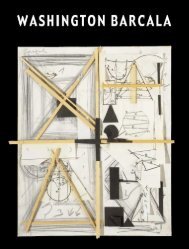VERSIÓN INGLESA ENGLISH VERSION - Fundación César Manrique
VERSIÓN INGLESA ENGLISH VERSION - Fundación César Manrique
VERSIÓN INGLESA ENGLISH VERSION - Fundación César Manrique
You also want an ePaper? Increase the reach of your titles
YUMPU automatically turns print PDFs into web optimized ePapers that Google loves.
168<br />
The universe illustrated in the Guacimeta mural, a sort of island inventory, was also depicted by<br />
<strong>Manrique</strong> on smaller works (nearly always monotypes on paper and a few oil paintings), which he<br />
painted with even greater freedom and audacity than the mural. Given the nature of fragments as<br />
intimate and private experiments, they were better suited than large public compositions, designed<br />
for mass public view, to the inclusion of expressive assays and the use of surprise and its effects. Works<br />
such as Desnudo azul (Blue nude) (1953) or Noche de malpaís (Night in the badlands) (1954) were a<br />
culmination of the way that <strong>Manrique</strong> had learned to translate the reality of the island of Lanzarote,<br />
so distant from the callow folkloric approach of his apprenticeship and at the same time closer to the<br />
genuine identity of the landscape and the local peoples.<br />
Matisse and Picasso were unquestionably the two artists who influenced his work most during<br />
this stage; from the former he borrowed the exultant freedom of colour, its use as an independent<br />
value, sufficient in itself to express emotion (emotion that was always sunny, vital, vivid) as a translation<br />
of an optimistic outlook on existence. From Picasso he inherited the free and easy approach to<br />
drawing, scenic composition subject to no external rules, but only to the internal demands of the<br />
painting itself.<br />
These paintings must have astonished the opaque artistic world of nineteen-fifties Madrid;<br />
<strong>Manrique</strong>’s monotypes must have dazzled eyes used to seeing a grey, dull type of art that reflected<br />
misery, ruin and abandon (environments portrayed by the nascent Madrid School, Eduardo Vicente, etc.,<br />
or established artists such as Benedito, Sotomayor, Sert, and others), art that was a reflection on a<br />
wretched Spain, impoverished by the war and the unending post-war. They may be thought to bear a<br />
certain resemblance to Francisco Cossio’s - a painter much esteemed by <strong>Manrique</strong> - works, or<br />
Benjamín Palencia’s; but the aesthetic refinement in the former’s still-lifes, which while transparent<br />
lacked the bright joy of <strong>Manrique</strong>’s scenes, and the monotonous insistence in Palencia’s paintings on a<br />
single theme, rural life, along with its treatment - with thick and aggressive pigment - and its characters,<br />
peasants whose gesture and expression convey a certain underlying squalor, clearly distinguish them<br />
from the Atlantic paradise that <strong>Manrique</strong> painted with such impulsive exultation 5 . The respective<br />
meaning in these works also differed: while one advocated the refined and secret intimacy of interiors<br />
(still lifes) and the other rural aggressiveness (in colour and gesture), <strong>Manrique</strong> proposed the carefree<br />
poetry of life under the sun with the cool breeze of the sea either present or close enough to sense.<br />
5. In any event, Palencia did not reveal his colourist<br />
tendencies until approximately 1950. “His austere<br />
landscapes” says José Hierro, referring to the change that<br />
took place in Palencia’s work towards the end of the<br />
forties, “ignited, burst into a flame of unreal colour. (...)<br />
Contrast was to replace the nuance in the colourist’s<br />
approach”. Artes, Madrid, May-June, 1970.
















![Becas y premios de la Fundación César Manrique [1997-2006]](https://img.yumpu.com/20766851/1/184x260/becas-y-premios-de-la-fundacion-cesar-manrique-1997-2006.jpg?quality=85)
